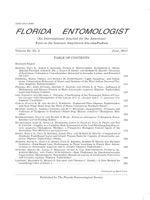Raoiella indica Hirst (Acari: Tenuipalpidae), the red palm mite, is a phytophagous mite that recently invaded the Western Hemisphere. This mite was first detected in Martinique (Flechtmann & Etienne 2004) and it rapidly spread to multiple islands of the Caribbean [St. Lucia and Dominica (Kane et al. 2005), Guadeloupe and Saint Martin (Etienne & Flechtmann 2006), Puerto Rico and Culebra Island (Rodrigues et al. 2007), and Cuba (de la Torre et al. 2010) among other islands]. In 2007, the mite was found in West Palm Beach, Florida (FDACS 2007), and in the state of Sucre, Venezuela (Vásquez et al. 2008), and more recently, reported in the northern state of Roraima in Brazil (Marsaro Jr. et al. 2009), and Isla Mujeres and Cancun, Mexico (NAPPO 2009).
In January 2010, high populations of R. indica were found attacking coconut (Cocos nucifera L.), banana (Musa acuminata Colla) and heliconia (Heliconia sp.) plants in the Tayrona National Park located in the Colombian Caribbean littoral, near the city of Santa Marta, Magdalena. The presence of multigenerational colonies and exuvia was confirmed in 18 coconut palms, 4 heliconias and multiple banana plants located near the coast in the northern part of the park (11°18′44″N 73°56′04″W). In further surveys R. indica infestations were detected in commercial coconut and banana groves in June 2010 at Los Naranjos, Magdalena (11°17′49″N -73°53′49″W), approximately 6 km East of the Tayrona Park along the coast. In this locality the predatory mite Amblyseius largoensis Muma (Acari: Phytoseiidae) was found showing a conspicuous red coloration of the alimentary tract indicating recent feeding on R. indica. Previous studies indicated that populations of A. largoensis increased in numbers after the arrival of R. indica to Florida and some areas in the Neotropics (Peña et al. 2009; Carrillo et al. 2010).
Raoiella indica and A. largoensis specimens were collected (70% ethanol) and subsequently slide mounted, identified, and deposited in the collections of the Laboratory of Plant Quarantine reference collection, Embrapa Genetic Resources and Biotechnology, Brasilia, Brazil, and the Laboratory of Acarology from the Instituto Agroforestal Mediterráneo, Universidad Politécnica of Valencia, Spain.
The experienced negative effects of R. indica on coconut production in the Caribbean, where yield reduction has been estimated in over 50% at some locations (CARDI 2010), indicate the importance of adopting regulatory and other control measures in areas of recent invasion. The establishment of chemical practices needed to allow movement of host plant material, and continuous surveying (pre and post-invasion) using sentinel sites, have been adopted to prevent R. indica's rapid dissemination in Florida (Roda et al. 2008). An integrated approach combining all available control tactics should be adopted and natural enemies identified for managing this species (Peña et al. 2009; Carrillo et al. 2010). In addition, studies are needed to determine the potential host plant range of R. indica in Colombia and the rest of the Neotropical region. Strict sanitary measures and other management tactics should be implemented to minimize the damage caused by R. indica in Colombia and other countries in South and Central America.
SUMMARY
In January 2010, high populations of Raoiella indica were reported for the first time in Colombia attacking coconut, banana, and heliconia plants in the Tayrona National Park. The predatory mite, Amblyseius largoensis, was found associated with R. indica in Los Naranjos, Magdalena. Strict sanitary strategies and other management tactics should be implemented to minimize the damage caused by R. indica in the Americas.





